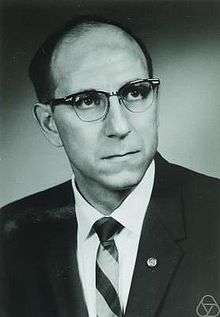Richard Arenstorf
| Richard F. Arenstorf | |
|---|---|
 Arenstorf in 1966 | |
| Born |
November 7, 1929 Hamburg, Germany |
| Died |
September 18, 2014 (aged 84) Nashville, Tennessee, United States |
| Residence | Nashville, Tennessee |
| Citizenship | American |
| Fields | Mathematics |
| Institutions | Vanderbilt University |
| Alma mater |
University of Göttingen University of Mainz |
| Known for | Arenstorf Orbit |
| Notable awards | NASA Exceptional Scientific Achievement Medal (1966) |
Richard F. Arenstorf (November 7, 1929 – September 18, 2014) was an American mathematician who discovered a stable orbit between the Earth and the Moon, called an Arenstorf Orbit, which was the basis of the orbit used by the Apollo Program for going to the Moon.[1] He died on September 18, 2014 of heart failure in Nashville, Tennessee.[2]
The Arenstorf Orbit
While the orbit of a satellite around the Sun was empirically discovered by Kepler and theoretically proven by Newton to be an ellipse, at the time when the United States was interested in going to the Moon, there was no such solution known for the shape of a satellite orbiting regularly around two objects, such as a spacecraft going between the Earth and the Moon. This is a special case of the infamous Three Body Problem, for which a general analytical solution is not known because of its complexity of solving the effect of three bodies which all pull on each other while moving, a total of six interactions. However the case of an Earth-Moon satellite can be simplified to four interactions, because although the three objects gravitationally all pull on each other, the effect of the spacecraft's gravity upon the motion of the vastly more massive Earth and Moon is practically non-existent. Arenstorf found a stable orbit for a spacecraft orbiting between the Earth and Moon, shaped like an '8' with the Earth or Moon located inside each loop of the '8'. This orbit is the basis of a path going to the Moon from the Earth, such as the United States Apollo program. For a permanent presence on the Moon, it would be the path of what Arenstorf calls a 'Space Bus', a ferry which could regularly orbit supplies and people between the Earth and Moon without directly expending fuel. By staying on the Arenstorf orbit, lunar astronauts automatically return to Earth. Before leaving NASA at the first Moon Landing, Arenstorf mapped out an emergency rescue orbit, which was used in the Apollo 13 incident, in which a catastrophic malfunction forced aborting the Moon landing, but the astronauts ultimately returned safely to Earth without a major course adjustment.
Additional career
After the first Moon Landing, Arenstorf became a professor of mathematics at Vanderbilt University, now retired, where he specialized in celestial mechanics and analytic number theory. In number theory, one speciality was the properties of the Riemann zeta function, which allows generalizations to be made about the nature of prime numbers.
Recognition and Awards
Arenstorf's portrait is found among Kepler and Newton in the "Museum" beginning the book, Foundations of Mechanics by Ralph Abraham.
Arenstorf received the NASA Exceptional Achievement Medal in 1966.[3]
Arenstorf received his Ph.D. from the Johannes Gutenberg University of Mainz in 1956.
Popular culture
In the movie Apollo 13, a sketch of the Arenstorf orbit is drawn on a chalkboard and referred to throughout the movie to mark the progress and dangers of the imperilled astronauts.
References
- ↑
- ↑ http://www.legacy.com/obituaries/tennessean/obituary.aspx?pid=172521091
- ↑ Astronautics and aeronautics, 1966 : chronology on science, technology, and policy, Scientific and Technical Information Division, National Aeronautics and Space Administration, 1967; p. 200
- David Salisbury, VU mathematician played key role in moon landing, Vanderbilt University News, July 2009. Accessed January 24, 2010
Ralph Abraham, Foundations of Mechanics, New York, W. A. Benjamin, 1967.